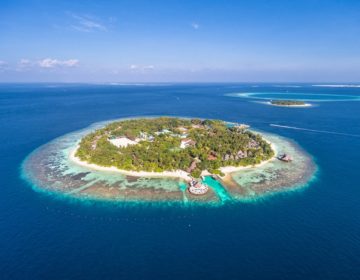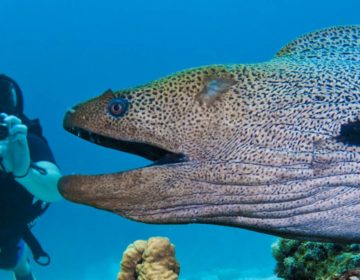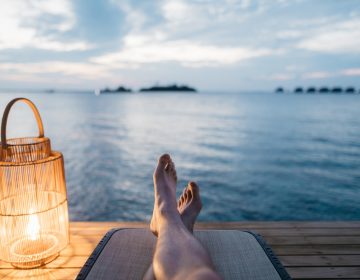Mulaku Atoll is 48 kilometers long and 31 kilometers at its widest point. It consists of nine inhabited islands and around 30 small uninhabited islands. Muli is the atoll capital, and there are two resorts, Medhufushi Island Resort, and Hakuraa Club. Another three resorts are proposed, namely Dhekunuboduveli, Gasveli, and Kudufushi Resort & Spa. All the islands lie on the outer reef of the atoll. The principal occupation of the inhabitants is cloth and rope weaving, fishing, some agriculture and employment at the two resorts. The atoll was significantly affected by the December 2004 Tsunami, and as a result, it is planned to reclaim land, fortify and build Muli into a tsunami-safe island for the region.
There are numerous coral reefs inside the atoll and many openings in the barrier reef in the western side of the atoll. There is only one large opening for most of the eastern side. This opening is very shallow and is split into two channels, Mulee Kandu and Mullah Kandu. The northeastern reef of the atoll is 28 kilometers long, and the southeastern reef is 35 kilometers long. Combined, they form a significant barrier to the eastern side of the atoll. The southern reef is unique because the entire length is connected by a shallow and wide lagoon that allows transport and fishing between the islands in the traditional style craft specially designed for shallow water travel. These are small dhonis (bokkuras), canoes (kadubokkura), and rafts (kadufati).

Dhiggaru
Dhiggaru is a heavily treed inhabited island, more than its close neighbor Maduvarri. Fishing is the main occupation of both islands. Dhiggaru has an 80-meter communications tower and is the first island to be seen when traveling south from Felidhe Atoll. There is a 12 mile light marking the west side of the entrance to Dhiggaru Kandu, and a two-mile light marks the outside reef of Maduvari. Maduvari Kandu is the main channel for boats heading north to south through the atoll.
 Dhiggaru Island
Dhiggaru Island
Raiymandhoo and Madifushi
Raiymandhoo and Madifushi have inhabited islands with small populations. They are off the main routes through the atoll and are less frequently visited. Raiymandhoo has a communications tower and a 12 mile light. A two-mile light marks the eastern tip of the atoll. Raiymandhoo became uninhabited in 1969, but the people went back there in 1975. There are several small uninhabited islands in a big shallow lagoon on the outer barrier reef between Madifushi and Veyvah.
 Raiymandhoo and Madifushi
Raiymandhoo and Madifushi
Boli Mulah
Boli Mulah is an uninhabited island also called Mullah. It was formerly the atoll capital and fishing and yam growing are the main occupations. There is a jetty on the north side of the island that offers excellent protection during the south-west monsoon, and a ferry travels from here to Malé at least once a week. During the heat of the day, islanders gather to sit under the trees near the start of the jetty and watch as boats try to anchor during the north-east monsoon and strong winds, creating plenty of interest. The island has a very shallow reef and long reef extending into Mulee Kandu. With heavy seas, waves from well out to sea and swells travel up to 500 meters before reaching more shallow water and breaking up. At times the waves break early, and boatmen are cautious here.
Veyvah
Veyvah is an uninhabited island and has an ancient mosque built by Sultan Mohammed Ibn Al-Haj Ali (1692 – 1701 AD). It has a two-mile light on its reef marking the northern side of Mulee Kandu. Close by the light is a ‘Tsunami tree.’ Many trees drifted onto the eastern reefs of the Maldives during the December 2004 tsunami.
 Veyvah Island
Veyvah Island
Muli
Muli is an uninhabited island that lies at the northern end of a 35-kilometer barrier reef. It is the capital of the atoll and includes the atoll office and a regional hospital. It has a newly reclaimed harbor with a protective outer wall that provides year-round safe anchorage and easy access to the inner lagoon. Boats from Hakuraa Club and Medhufushi Island Resort, make many of their transfers through this harbor entrance. Coconut trees have been planted around the perimeter of the harbor to provide shade for many safari boats that stop here during rough weather. Boat building is also a feature of this island with boats up to 100 feet being built. If they are any longer, then the owner has to pay a significant increase in fees when landing in Malé harbor.
A large part of the inner and outer sides of the island have been reclaimed. On the outside reef, rubble and rubbish from the 2004 tsunami have been pushed into the sea to provide extra space. Muli is being developed as a safe island for the region, and a much larger area is to be excavated and reclaimed for the future. The northern end of Muli is a renowned turtle breeding area, and a sanctuary is a proposed to protect the area from housing development and unwanted intrusion. There is a small island, Boahuraa, located on the northern side of Muli that is accessible at low tide. It is a favorite fishing location for the Islanders and humpback snapper are regularly caught by handline off the reef of this island.
![]()
At low tide, large areas of sea grass are visible, and many small shells are seen feeding among it. A 12-mile light on the reef at the end of the island marks the southern end of Mulee Kandu. Following the tsunami, rubbish of all description covered the reefs of Muli and adjacent islands. A small, uninhabited island, Maalhaveli, lies 1.5km to the south of Muli. A ship called the Prazer E Allegria was wrecked on the reef near this island on March 17, 1844, with the loss of 11 lives. It is a very picturesque island, about 150 meters long with a good beach on the inner side.
Naalaafushi
Naalaafushi is a small, uninhabited island with a jetty on the inner reef side. A small channel has been cut through the inner reef to provide access to the deeper waters inside the atoll. The island has an ancient mosque, and houses and walls are built of coral stone. There was considerable damage to the mosque during the tsunami, exposing stones with old engravings and inscriptions. Traditional use of log canoes known as ‘kadubokkura’ and rafts called ‘kadufatis’ are commonly used on the shallow inner lagoons that extend the length of the southeastern reef of the atoll. These are lightweight made from breadfruit trees. The women of the island are proficient rope makers. ‘Roano’ or rope, is made from coconut fiber that is first washed in the sea and is then twisted and joined into long strands.
 Naalaafushi Island
Naalaafushi Island
Kadufati
The large shallow lagoons in Mulaku Atoll mean traditional-style mas-dhonis and bokuraas are often not suitable for crossing the outer barrier reef at low tide. So, for this area, the islanders developed rafts known as ‘kadufati.’ They are extremely light and made of several logs from the Kadu, or breadfruit tree. They are about five meters in length and braced together by means of wooden pegs and lashings. The end of the raft is beveled upwards, and poles propel it through the water. When loaded, the raft rides just below the surface of the water. The Kadufati were also used to catch turtles and go fishing, and they are still used in other areas of the Maldives, such as Huvadhoo Atoll.
Medhufushi
Medhufushi Island Resort, is close by Naalaafushi and is separated by a narrow channel. There are three uninhabited islands between Medhufushi, and Hakuraahuraa (now a resort called Cinnamon). Seedihuraa is a tiny island with bushes, and four or five coconut trees joined by a sandbank to a sandy island with bushes called Seedihuraa Veligandu. Three hundred meters away is the third island with a few coconut trees and shrubs but with very little, if any, sand. Another sandbank called Gongalu Huraa appears to be primarily washed away. Hakuraahuraa is a long island with many water bungalows and a 500-meter-long jetty crossing a large, shallow lagoon. Windsurfers and catamaran users are fortunate to have access to this large lagoon area.
There are several uninhabited islands between Hakuraahuraa and Kolhuvaariyaafushi. However, access to them is restricted by the shallow lagoon and reef. Three of them, Dhekunuboduveli, Gasveli, and Kudausfushi are proposed resort islands.
 Medhufushi Island Resort
Medhufushi Island Resort
Kolhuvaariyaafushi
Kolhuvaariyaafushi is an uninhabited island that lies amid a group of uninhabited islands at the southern end of the atoll. The island was greatly affected by the 2004 Tsunami, most of the houses were washed away, and by the end of 2005, half the population of the 1,213 people that lived on the island were living in temporary accommodation awaiting homes to be built, while the other half were living in Malé. Fortunately, the island has a good harbor for landing craft and fishing and yam growing are the principal occupations of the Islanders. There are two villages on this island that were joined together in 1962.
The main attraction of if the island here is the old mosque on the southeast corner overlooking the small island of Dhiththudi. A long avenue with stone walls leads up to the mosque. The mosque was originally built with the remains of the Kalhuohfummi, wrecked n the nearby reef in 1573 (see story below). It has caught fire once and has been rebuilt and was also severely damaged in the 2004 tsunami. Headstones were upgraded, and the roof and stone walls collapsed. This revealed some of the magnificently cut coral stones lying under more recent additions to the mosque. The old woodwork structure inside remained in place.
Kurali
Kurali is one of only five uninhabited islands on the entire west side of Mulaku Atoll. It lies at the southern end and has a tiny islet called Kuradhigandu nearby on the same reef. Kurali Kandu is the main channel in the south of the atoll through which boats pass. There is a big shallow reef near Kurali that is a favorite fishing area for local islanders.
The next island north is Thuvaru. It was inhabited until 1970 and is now uninhabited, although it is leased and has a house with several workers who farm chilies, bananas, and watermelon. The remains of a few houses lie crumbling in the thick vegetation. The island has beautiful sandy beaches, a shallow lagoon and a jetty on the northeast side. For a small fee, visitors from safari boats and the resorts of Medufushi and Hakuraa Club have picnics here. This island is noted for a flock of about 20 herons, known locally as Markaru. They line the beaches in the morning and evening awaiting prey, and at other times they nest in the coconut trees.

Raabandhihuraa and Fenboafinolhu are tiny uninhabited islands.
Kalhuohfummi
The Kalhuohfummi was the odi of the National Hero of the Maldives, (Sultan Ghazi Muhammed Thakurufaanu, 1573 – 1585). It was built on the island of Baarah, in Haa Alifu and on its maiden trip, it was noted that certain fish (kaluoh) were jumping (fummi) out of the water after the boat, hence the name stuck.
In 1573, Muhammed Thakurufaanu led a small band of patriots to overthrow the Portuguese in Malé after a 15-year period of occupation. His odi was renowned for its sailing qualities, having proved too fast for the Portuguese vessels. After defeating the Portuguese, the Kalhuohfummi was quickly reconditioned and sailed down to the southern atolls to strengthen the rule of Islam and to confront a rebel islander, Meedhu Thakur.

Muhammed Thakurufaanu defeated Meedhu Thakur and then visited many of the uninhabited islands in the southern atolls. He was dismayed at what he found. Many inhabitants could not tell which day was Friday, and they knew a lot about charms, black magic, and sorcery, but little about Islam. He prohibited the consumption of ‘toddy,’ an alcoholic drink, and forbade men and women taking sea baths in the nude. He also separated the areas on beaches where men and women went to relieve themselves.
Muhammed Thakurufaanu also visited the island of Vaadhoo in Gaafu Dhaalu. It is recorded in the legend that while on the island he took a Khadaa Walhu or metal bowl, that was near the house of an old lady. She did not approve of this and became angry, and that is why, it is said, his odi was wrecked.
On the return journey back to Malé while traveling between Thaa and Meemu atolls, the Kalhuohfummi got caught in a severe storm. It was raining heavily, night time was approaching, and the boat was leaking badly. Muhammed headed towards the nearest island in Meemu Atoll and struck the reef at Dhiththudi near the island of Kolhuvaariyaafushi.
In the morning, they took everything from the boat to the island and went to perform their Fathis prayer. Muhammed Thakurufaanu was disappointed not to find a mosque, so he ordered the Kalhuohfummi to be dismantled and all the wood from the wrecked vessel to be used for the construction of a mosque. Various features of the Kalhuohfummi, such as the mast and the rudder, were displayed, as well as a sword captured by the Portugues. When the mosque was finished, Muhammed Thakurufaanu and his crew returned to Malé. Many years later this famous mosque was burned down in an accident, and another was built on the same location with replicas.

(Source: Dive Maldives: A guide to the Maldives Archipelago. Tim Godfrey. Atoll Editions)



